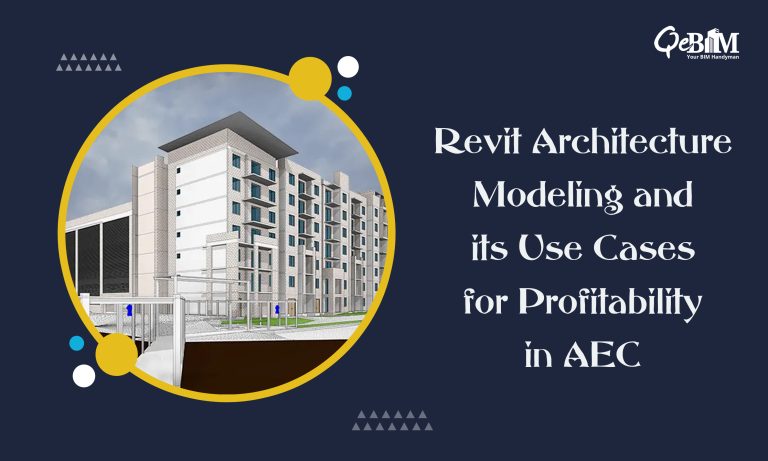Revit Architecture Modeling and its Use Cases for Profitability in AEC

BIM architecture has transcended its initial stages to become a pivotal aspect of architecture and construction workflows. The global BIM market is estimated to increase up to USD 15 billion by 2028, as per Autodesk. This growth can be attributed to the elevated benchmarks established by numerous BIM services, Revit Architecture Services being one of them.
Considering the fast-paced architectural scenario, efficiency and accuracy are important to ensuring profitability. With technological advancements like BIM Outsourcing Services shaping the industry, architects and designers are constantly seeking innovative tools to streamline their processes and deliver exceptional results. Among these, Revit Architecture Modeling stands out as a game-changer, offering a plethora of benefits that not only enhance design quality but also significantly boost profitability.
The Concept of Revit Architecture Modeling
Revit Architecture Modeling, developed by Autodesk, is a BIM software that empowers architecture and construction professionals to plan, design, imagine, iterate, and collaborate on buildings and infrastructure projects. Its robust features and capabilities empower users to create detailed 3D models that serve as comprehensive representations of their designs. Let’s delve into how leveraging Revit Architecture Modeling can drive profitability in the architectural realm.
7 Key Uses of Revit Architectural Modeling
1) Integrated Design Process: Revit facilitates an integrated design approach by allowing architects to collaborate seamlessly with engineers, contractors, and other stakeholders throughout the project lifecycle. This integration minimizes errors, reduces rework, and ensures alignment among all parties involved. By fostering clear communication and coordination, projects progress smoothly, thereby saving time and resources, ultimately leading to increased profitability.
2) Efficient Iterative Design: One of Revit’s standout features is its parametric modeling capabilities, which enable architects to create design iterations rapidly. Whether exploring different concepts or responding to client feedback, Revit’s intuitive interface and flexible tools facilitate quick modifications without compromising accuracy. This agility in the design process not only enhances creativity but also accelerates project timelines, allowing firms to take on more projects and maximize revenue streams.
3) Accurate Quantity Take-offs and Cost Estimation: Revit’s BIM functionalities extend beyond design to include detailed information about building components and materials. This data-rich model enables automatic generation of quantity take-offs and accurate cost estimations, eliminating the need for manual calculations or guesswork. By having precise insights into project costs early on, architects can make informed decisions, optimize budgets, and avoid cost overruns, ultimately safeguarding profitability.
4) Visualizations for Client Engagement: In today’s competitive market, compelling visualizations play a crucial role in winning client trust and securing projects. Revit’s powerful rendering engine and visualization tools allow architects to create photorealistic images and immersive 3D walkthroughs that effectively communicate design intent to clients. By offering clients a glimpse into the finished project before construction begins, architects can foster confidence and enthusiasm, leading to higher client satisfaction and repeat business opportunities.
5) Streamlined Documentation and Coordination: Documentation is an essential aspect of architectural projects, often requiring meticulous attention to detail. Revit simplifies this process by automatically generating construction documentation, including plans, sections, and elevations, directly from the 3D model. Furthermore, Revit’s ability to detect and resolve clashes among building elements ensures coordination between different disciplines, minimizing costly conflicts during construction. By streamlining documentation and coordination, architects can increase the project efficiency thereby reducing the chances of delays, errors or disputes, ultimately maximizing profitability.
6) Sustainable Design Optimization: With sustainability becoming a key consideration in modern architecture, Revit offers tools to optimize designs for energy efficiency and environmental performance. From daylighting analysis to energy simulation, architects can leverage Revit’s built-in sustainability features to design greener buildings that not only reduce operating costs but also enhance marketability. By aligning with sustainable design principles, architects can attract environmentally conscious clients and command premium fees, thereby increasing profitability in the long run.
7) Expanded Service Offerings: The versatility of Revit extends beyond traditional architectural projects to encompass a wide range of design disciplines, including interior design, landscape architecture, and urban planning. By diversifying their service offerings and leveraging Revit’s capabilities across various project types, architectural firms can tap into new markets and revenue streams. Additionally, the ability to collaborate with multidisciplinary teams further expands the scope of projects, fostering innovation and driving profitability through increased project diversity.
Conclusion:
Revit Architecture Modeling serves as a catalyst for enhancing profitability in the architectural industry by streamlining processes, improving collaboration, and delivering superior design outcomes. By embracing this innovative tool and harnessing its full potential, architects can stay ahead of the curve, differentiate themselves in the market, and ultimately achieve greater financial success. As technology continues to evolve, Revit remains a cornerstone of modern architectural practice, empowering professionals to transform visionary ideas into profitable realities.